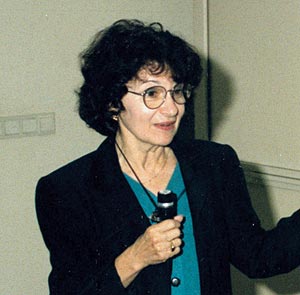The Biology of Memory
Patricia Goldman-Rakic ’59 was known for saying, “My life is devoted to science.” CNN agreed, and in its celebration of the new millennium, it named her “America’s best neuroscientist” in 2001. Last year Patricia Goldman-Rakic died suddenly in a tragic car accident.
Then at the peak of her career, she was the Eugene Higgins Professor of Neurobiology at Yale where she was also professor of psychiatry, neurology, and psychology. Like many of our classmates, we learned at that time of the breadth of her scientific contributions, especially the area she called “working memory,” the kind of memory that allows us to retrieve stored information, such as remembering a telephone number, constructing a sentence, or driving a car. As part of the Vassar community we are proud of Pat’s brilliant contributions to understanding the pathophysiology of such devastating conditions as schizophrenia, Parkinson’s, and Alzheimer’s disease. Pat’s achievements distinguish her as one of Vassar’s most notable graduates.
We knew her as Patricia Shoer, who along with her twin sister, Ruth Shoer Rappaport, was our classmate. Patricia was one of seven psychology majors. She enjoyed music, the arts, and the challenge of cooking and household chores at Ferry House. But above all she loved science. Co-major Karen Dahlberg VanderVen ’59 remembers Patricia’s lively intelligence in their senior psychology seminar and her generosity and grace in helping Karen design the recruitment and coding of subjects for her complicated thesis. Pat continued to nurture and mentor students and colleagues as she had at Vassar. As a senior researcher she thought of her graduate students as her “scientific children.”
Pat broke down gender barriers in her field and made a name in a scientific world where women were not expected to succeed. After graduating from Vassar Pat earned her doctorate at the University of California at Los Angeles, and after a post-doctoral appointment at the Museum of Natural History in New York City, she went to the National Institute of Mental Health at the National Institutes of Health (NIH) in Bethesda, Maryland. There she focused on the frontal and prefrontal cortex, an area of the brain that was then essentially terra incognita, “a big chunk of the brain, the size of a fist,” which nobody knew much about at the time. Seeking an animal model, she selected the rhesus monkey, whose brain is very similar to that of a human. She developed intricate and delicate procedures for placing minute lesions into the prefrontal cortex to explore how the lesions affected the animals’ learning and memory functions. At a time when few women at the NIH rose to senior levels, Pat became chief of a laboratory section.

In 1979 she married fellow neurobiologist Pasko Rakic and eventually joined him at Yale, where she built a remarkable research team. As Pat and Pasko merged their lives, their research interests moved closer as well. Pat studied the function of the prefrontal cortex, while Pasko studied its development. Together they founded the journal Cerebral Cortex. A scientific colleague described their partnership as the merging of “great synergies.” At Yale Pat continued to explore the cellular and molecular basis of cognitive processes in nonhuman primates, including the role of neurotransmitters, notably dopamine, which in human development affect conditions and disorders such as schizophrenia and Parkinson’s disease. Her colleagues attribute her success, in part, to her mastery of multidisciplinary skills. Something of a renaissance woman in her field, she combined anatomy and pharmacology in her exploration of the neural circuitry of the frontal lobe and its relation to other parts of the brain. In primates, and later in humans, she understood aspects of the biological basis of cognition, sensation, movement, and emotion in normal behavior, which enabled her to probe the neurobiological foundations of the whole spectrum of brain-related disorders. She published these discoveries in over 300 papers and earned the scientific equivalent of the Triple Crown, election to the National Academy of Sciences, the National Academy of the Arts and Sciences, and the Institute of Medicine.
These accomplishments will be carried on by the scientists she nurtured. At a memorial service in Yale’s Battell Chapel, one after another of her colleagues, some her former students, remembered how she had encouraged their efforts. They recalled her confidence in them and how the warmth she and Pasko provided in their home enriched their lives. Vassar’s own Director of the Program in Neuroscience and Behavior Kate Susman reflected on Pat’s influence: “She visited Vassar on a number of occasions, including as the keynote speaker for the URSI Symposium, and impressed many with her grace and elegance, as well as her intellectual and scientific rigor. She was a strong supporter of Vassar science, in particular of Vassar women undergraduate scientists.” She leaves behind a huge void, but a great legacy of scientific enterprise, creativity, and imagination.
